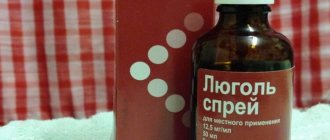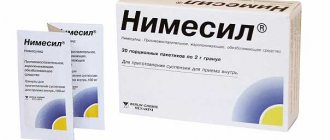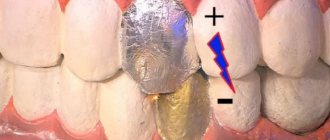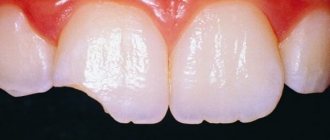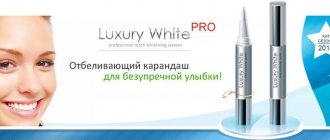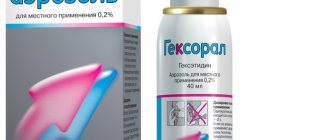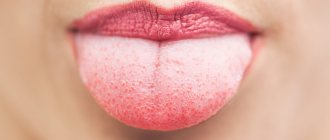Canker sores are a common oral condition in children, although adults can also suffer from symptoms. Since children are often the patients, you need to be careful when choosing drugs for the treatment of stomatitis. Vinilin for stomatitis is one of the most popular drugs; it is also called Shostakovsky’s balm.
General information
Vinilin (Shostakovsky balm) is an anti-inflammatory, antimicrobial and wound-healing drug used for a wide range of infectious pathologies.
The medicine is a liquid solution for topical application. In addition, there is a drug in the form of an ointment.
The solution is a yellow viscous substance, poorly soluble in water. It has a specific smell.
The main active ingredient is polyvinox (polyvinyl butyl ether). This component has an antibacterial effect by inhibiting the growth of pathogenic microflora.
The substance is also characterized by an enveloping effect, due to which the medicine has anti-inflammatory and wound-healing properties.
In addition to stomatitis, the drug is used for the following pathologies:
- Burns;
- Ulcerative diseases;
- Skin dermatitis;
- Infectious diseases in purulent form;
- Haemorrhoids;
- Frostbite;
- Boils.
In dentistry, Vinilin is used in the treatment of gingivitis, periodontal disease, inflammation of the tongue, and periodontitis.
Treatment with vinylin, Shostakovsky balm
Posted on November 29, 2015 by annapetrovna
There is a simple pharmaceutical drug that you need to have in your home medicine cabinet as an emergency medicine. This is Shostakovsky's balm. Or its other name is Vinilin. This balm was created in 1940 as an artificial substitute for natural essential balms: Fir, Vishnevsky.
After lengthy research in several clinics, it was found that Vinilin’s therapeutic effect is not inferior to these natural drugs, and sometimes even surpasses them.
Shostakovsky balm has a strong antiseptic effect, inhibits the growth of microorganisms and has a beneficial effect on healing processes and promotes regeneration of the skin and mucous membranes.
It should be noted that this drug has analgesic, anti-inflammatory and enveloping properties. The active ingredient of this drug is polyvinox, which has an anti-inflammatory, antimicrobial effect, stimulating epithelial regeneration.
The balm is not a toxic substance and does not cause side effects in the body, no matter in what quantities it is used.
The drug is available in the form of a balm and soft gelatin capsules (1 capsule of polyvinox 1.4 g). The balm is sold in dark glass bottles of 50, 100 and 180 ml. The balm consists only of 100% polyvinox.
The balm can be used in its pure form, as a 20% solution in vegetable oil (for example, rosehip oil, sea buckthorn oil) and as an ointment (the balm is compatible with other creams, pastes and ointments).
Efficacy for stomatitis
Vinilin is considered one of the most effective remedies in the treatment of various forms of stomatitis. The medicine helps eliminate the cause of the pathology - infection, due to which the symptoms disappear in a short period of time.
How does the medicine work?
The drug envelops wounds, preventing the negative effects of the salivary gland or bacteria entering the mouth with food
Stomatitis is an infectious disease that occurs when the tissues of the oral mucosa are damaged by pathogenic microorganisms.
The disease can also be caused by trauma and damage to oral tissues, or by taking medications that affect the balance of oral microflora.
Vinilin prevents the growth of bacteria, which is why the disease cannot progress.
The infection present in the oral cavity gradually dies. At the same time, Vinilin promotes the healing of ulcers that occur against the background of stomatitis.
The drug envelops wounds, preventing the negative effects of the salivary gland or bacteria that enter the mouth with food.
Advantages and disadvantages
The main advantages of the drug include:
- Possible discomfort when applying the drug in the oral cavity
Effective against a wide range of bacteria;
- Pronounced effect in all forms of stomatitis;
- Easy to use;
- Low likelihood of side effects;
- Possibility of admission in childhood;
- Possibility of combination with other medicines (paraffin, vegetable oils);
- Affordable price.
Important to remember! Vinylin has many advantages over other local antibacterial agents. However, in severe forms of stomatitis, it should be taken in combination with other medications.
The disadvantages of Vinilin include:
- Do not use during pregnancy and lactation;
- Possibility of side effects if a large amount of the drug enters the stomach;
- Possible discomfort when applying the drug in the oral cavity.
The medicine does not contain flavorings and fragrances, which are often used in other products for application in the oral cavity.
However, it may cause discomfort when treating stomatitis, but is more of an advantage than a disadvantage.
The presence of additives that improve the taste of drugs causes excessive salivation, which may reduce the effectiveness. Vinilin does not have this drawback, and therefore the effect when taken is more pronounced.
Types and symptoms of stomatitis
Stomatitis is an acute inflammation of the oral mucosa. Most often, the disease affects the mouths of children. It is noteworthy that often the child either does not experience symptoms of stomatitis at all, or suffers from its frequent relapses.
Stomatitis can affect the mucous membrane locally (one lesion) or extensively. Symptoms of the pathology are pronounced: ulcers appear in the mouth, gums swell, and an unpleasant odor occurs. Some patients have a fever.
Treatment for stomatitis should be prescribed by a dentist. Often, treatment is local, using several agents. In the case of stomatitis, early diagnosis is extremely important. Before prescribing therapy, the doctor must identify the cause of stomatitis.
Types of stomatitis
- bacterial (small ulcers that turn into ulcers and erosions);
- viral (bubble rashes with transparent contents, which become secondarily infected and turn into erosions);
- herpetic;
- allergic;
- fungal (thick white coating);
- radial (abundant separation of epithelium);
- chemical (scarring ulcers, deformation of the mucosa).
As a rule, stomatitis ulcers cover the inner surface of the cheeks and lips, sometimes the area under the tongue. The disease causes acute pain, burning and severe discomfort while eating and even talking.
Clinical forms of stomatitis
- Catarrhal. The mucous membrane becomes red and inflamed, swelling occurs.
- Ulcerative. Erosion occurs, which deforms the mucosa and deepens into the submucosa. The ulcers have a white-gray or purulent coating. Sometimes the lymph nodes become enlarged and the body temperature rises.
- Aphthous. A type of ulcerative stomatitis. Aphthae have clear contours, a round shape and red outlines.
Infectious-traumatic and bacterial stomatitis has been treated with Vinilin for many years. This is a proven and effective remedy that has a pronounced antimicrobial effect, cleanses ulcers and restores the mucous membrane.
How to use Vinilin?
The drug is intended for local application to affected areas of the mucous membrane. When treating ulcers, it is necessary to follow the antiseptic rules and instructions to prevent aggravation of the infectious process.
Instructions for use of the solution
In most cases, for stomatitis, the standard form of release is used - an oil solution.
Procedure:
- It is necessary to open the container with the medicine in advance, prepare a gauze or cotton swab
It is necessary to open the container with the medicine in advance, prepare a gauze or cotton swab;
- Hands must be washed thoroughly;
- Apply a small amount of solution to the tampon;
- The affected areas are lubricated with a tampon.
If the patient is prescribed a mixture of drugs, it should be prepared before starting the procedure.
In some cases, medicinal mixtures with Vinilin are prepared directly in the pharmacy.
Using ointment
Vinilin is taken in the presented form most often for skin lesions, but can be used to treat diseases of the oral cavity.
Mode of application:
- The procedure should be performed no less than 1 hour after eating
- Before the procedure, you should wash your hands thoroughly
- Apply ointment to a cotton swab or stick
- Smear ulcers on the mucous membrane
After applying the ointment, profuse salivation is possible. It is not recommended to swallow salivary fluid along with the ointment to prevent negative consequences from the digestive system.
Application for child
Treatment of the child's oral cavity
Vinilin is often used in pediatrics to treat stomatitis.
In childhood, it is recommended to use Vinilin solution, since when taking the ointment, it is possible to develop allergic reactions to the auxiliary components of the medicine.
The solution is applied to the sores in the child's mouth using a cotton swab or swab.
To improve the taste and thus make it easier to take, you can add peppermint oil to the solution, which also has many beneficial properties.
If the solution is applied to an infant, the procedure must be performed at least 2 hours after feeding.
Terms of use
On average, the course of treatment is 5-7 days. A pronounced effect from taking it is observed 2-3 days after the start of Vinilin therapy.
Reception mode:
- Adults are recommended to apply the medicine 4-5 times a day. In this case, at least two hours should pass between each dose.
- For children, the medicine is applied three times a day. The minimum time interval between procedures is 3 hours.
Dosage
Before administration, the medicine is applied to a cotton or gauze swab. For adults, 3-5 ml of the drug is enough for one treatment. In childhood, a few drops are also sufficient for the procedure.
Important to remember! The dosage regimen and frequency of administration may vary depending on the severity and form of the disease.
Pharmacodynamics and pharmacokinetics
Pharmacodynamics
Polivinox improves tissue restoration and healing, providing an additional anti-inflammatory effect. It also demonstrates local antimicrobial and enveloping effects.
Pharmacokinetics
The antiseptic effect is caused by the ability of the drug to dehydrate microbial cells, coagulating protein and thereby provoking the death of microbes. As a consequence, restoration occurs by replacing the area of necrosis with connective or specific tissue.
When used externally, it promotes epithelization, wound cleansing, and tissue regeneration.
Vinyline for chronic stomatitis
Chronic stomatitis is treated with Vinilin exclusively in combination with other drugs
The described drug can be used to treat the chronic form of the disease.
However, the effect when taken is less pronounced than in acute stomatitis.
This is due to the fact that chronic infection is less sensitive to antiseptic substances.
Chronic stomatitis is treated with Vinilin exclusively in combination with other medications.
Drug therapy for this disease is aimed, first of all, at eliminating the factors that provoke re-infection.
Local antiseptics, which include Vinilni, are used for auxiliary purposes.
How to take care of your nails
Well-groomed nails are one of the best decorations of our hands. Even if you don’t have time to visit the salon, you should pay proper attention to your nails at least once a week. Especially if you like active recreation in the form of hard work in the country or trips to the nearby forest for a picnic. You can get rid of ingrained soil and return your nails to a well-groomed appearance without much difficulty.
A few tips Before you start manicure, wash your hands thoroughly with soap, removing any remaining polish with conditioner with vitamins.
After removing the polish, the nails are shortened and given the desired shape. If you have a wide palm, then medium-length and square-shaped nails will look best. The best option for all types of brushes is oval nails. After trimming your nails, be sure to smooth the sharp, scratchy edges with a special nail file. Move it lightly, without pressure, only towards the middle, trying not to grind down the smooth surface of the nail. Nails should be filed in one direction - then they will not split.
To get rid of stubborn dirt, take a lemon, cut off the edge and dip your nails into the pulp. Leave the juice on your nails for three minutes. Wash it off and get perfectly clean nails. In a similar way, you can solve the problem of yellow nails, which is often found in smokers.
Then the hands are dipped into a hot soapy water solution so that the nail skin gets wet and steamed. The duration of the bath depends on the structure of the skin. Some women need 15 minutes, while others have skin so soft and pliable that after 3-4 minutes you can treat your hands.
After the skin has become soft, a nourishing cream is rubbed into it, and the nail skin along with the nail fold is moved and removed using nail clippers. Excessive removal of skin in places of contact with the nail bed is unacceptable - this will not make the nail larger, but the wound can become inflamed and cause nail loss.
After treating the skin around the nail and carefully removing hangnails with scissors, the nail fold is treated with a cotton swab moistened with a 3% solution of hydrogen peroxide and olive oil.
Now you can apply polish to your nails and complete the procedure by lubricating your hands with nourishing cream. If you are sensitive to polish, or simply don't want to wear polish often, you can increase the shine of your nails by using lemon juice or grape vinegar, or by buffing your nails until they shine with a piece of suede...
To make your nails look healthy, include in your diet more foods containing vitamin A (cottage cheese, milk, liver, eggs, fish, nuts, carrots, spinach, pumpkin), and also often eat jelly from berry juice - cranberries, currants, etc. d.
The simplest and most affordable way to get rid of layered nails are baths using sea or ocean salts. Dissolve a tablespoon of salt in a glass of warm water and soak your fingertips in it for 15-20 minutes every day. It is useful to pamper fragile and brittle nails 1-2 times a week with baths of warm vegetable oil (ideally olive oil). Add a few drops of vitamin A (available at the pharmacy), 3 drops of iodine and 5 drops of lemon juice.
Today the European style is popular, that is, a rectangular shaped nail plate. As for paints, color fashion is constantly changing. In summer, the color of ripe berries is considered extremely relevant. And for the winter, mother-of-pearl is offered in a variety of shades: pink, beige, steel. By the way, it is recommended to apply pearlescent varnish in two layers, and any other, regardless of color, in three.
The foil effect and artistic painting are also very fashionable: there can be several colors on one nail plate. Those who prefer an avant-garde style can use decals that are applied to the varnish. Rhinestones—small shiny stones—are also popular these days. Of course, on all fingers they will look vulgar, but on one finger they will look quite original and even piquant.
One of the most elegant ways to decorate your nails is a French manicure. When performing a classic French manicure, a base is applied to the nails, allowed to dry, and the nails are covered with a natural-colored varnish. It is best to use transparent varnishes in delicate shades. When this varnish has dried, white varnish is applied to the tip of the nail, and then the entire free edge of the nail is covered with white varnish. It is better to start the coating from the right side edge, moving the brush to the middle of the nail, and then repeat the same on the left side. Once this coat has dried, apply one or two coats of pink polish to the entire nail, and finally coat your nails with topcoat.
Contraindications and side effects
The medicine has a small number of contraindications, so it can be used by almost all patients without restrictions.
Contraindications for use are:
- Vinilin extremely rarely provokes side effects
Pregnancy;
- Lactation period;
- Children's age (up to 14 years for the drug in the form of ointments and oral capsules);
- Hypersensitivity to components;
- Severe renal or liver failure.
Vinilin extremely rarely provokes side effects.
In most cases, the use is well tolerated even with long-term therapy and in case of excess dosages.
Possible side effects:
- Skin rash;
- Itching and burning at the application sites;
- Increased salivation;
- Discomfort in the abdomen after applying ointments.
Contraindications to the use of Vinilin
Vinylin is contraindicated for use in the following situations:
- Diseases of the liver and gall bladder (for oral use).
- Kidney diseases (for oral use).
- Children's age (for oral use).
- During pregnancy and breastfeeding, taking Vinilin orally is not recommended (external use is possible).
- Individual intolerance to the drug. The use of balm and capsules can provoke allergies due to hypersensitivity to the drug
- https://natyropat.ru/tselebnyie-mazi/lechenie-vinilinom-balzamom-shostakovskogo.html
Cost and analogues
The price of the drug Vinilin differs depending on the manufacturer, volume, and other features.
On average, the cost of a medicine is:
- Solution 50 ml – 130 rubles;
- Solution 100 ml – 170 rubles.
In the treatment of stomatitis, drugs analogues of Vinilin can be used, which have the same mechanism of action and are highly effective.
The most common analogues are presented in the table:
| Name | Price | Short description |
| Polivinox | 140-170 rubles per 100 ml | Direct analogue of Vinilin. The active ingredient is polyvinylbutyl ether. The method of administration and dosage are the same. |
| Polyvinyline-Rusfar | From 139 to 170 rubles per 50 ml | It is an antiseptic used for trophic ulcers, burns, wounds, and furunculosis. The mode of action and composition are similar to Vinilin. Also available in ointment form. |
| Iodoform | From 190 rubles | The drug is in powder form for the preparation of a suspension for topical application. After application to the affected areas, the product releases iodine particles that have an antiseptic effect. |
| Sodium tetraborate | From 26 rubles per bottle of 30 g | An antibacterial drug used for infectious lesions of the mucous membranes and skin. Can be prescribed in childhood for the treatment of stomatitis. |
| Elekasol | From 50 rubles for 1 sachet | It is a herbal collection that includes plants that have antiseptic and anti-inflammatory properties. The composition includes chamomile flowers, marigold, and licorice root. Used to prepare a decoction used for topical treatment or mouth rinse for stomatitis. |
Diagnostics
In addition to clinical blood and stool tests, ultrasound, endoscopy and X-rays with barium sulfate are used to establish an accurate diagnosis of the disease.
X-ray examination allows you to detect direct and indirect signs of the disease.
Endoscopy provides the most informative information confirming the presence of the disease. It clarifies the size, shape and location of the ulcer, allows you to accurately assess the condition of the ulcer and identify changes in the mucous membrane. As a result of the procedure, it is possible to obtain histological material for a complete study - boipsia.
Common Questions
Does Vinilin help with aphthous stomatitis?
Aphthous stomatitis is a direct indication for the use of Vinilin. However, before starting treatment, it is recommended to undergo a series of diagnostic procedures to make sure that the disease is caused by bacteria and not other pathogenic microorganisms.
Can Vinylin be used during teething?
Many pediatricians recommend using the drug during teething. Systematic application eliminates signs of gum inflammation, facilitates the process, and also prevents possible infection.
Reviews
We present to your attention user reviews about the drug Vinilin, its effectiveness for stomatitis and other dental diseases.
Vinilin is an antiseptic substance with a wide range of applications. The medicine is actively used in the treatment of stomatitis and other dental diseases caused by exposure to pathogenic bacteria.
Vinyline is harmless to the body and can be used at an early age. Reception must be carried out in full accordance with the prescribed timing and dosage.
Symptoms of the disease
The clinical manifestation of the disease is varied. Symptoms may be pronounced, blurred, or not appear at all. They depend on the age of the patient, the size and location of the ulcer, and the presence of other gastrointestinal diseases.
The most common are severe pain syndromes of a stabbing and cutting nature, localized in the upper abdomen with a return to the left shoulder blade, lower back, and left hypochondrium.
In addition to pain, the disease is characterized by painful heartburn, sour belching, nausea and vomiting, and constipation.
